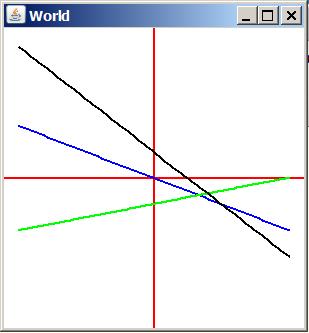| << Chapter < Page | Chapter >> Page > |
A Turtle object has the ability to connect two points with a straight line if, and only if, both points are inside the World object. If a point is outside the world and a turtle attempts to move to it, theturtle will behave like a dog inside a fenced yard running along the fence and barking at someone who is walking along the sidewalk on the other side of the fence. The turtle willmove along the inside boundary of the world. This is indicated by the black horizontal dotted line segments in the upper left and lower right of Figure 3 . In this case, the turtle was trying to reach a point somewhere on the extension of theblack line outside the world.
In comparison, Figure 4 shows the same lines as Figure 3 . The horizontal and vertical scaling were adjusted in Figure 4 to ensure that the end points of all three lines are inside the boundaries of the world. These lines could be drawn by a Turtle object using only the end points of the lines and only two points would be needed for eachline.

In general, a turtle is incapable of reliably drawing a straight line betweentwo points if either or both the points are outside the boundaries of the world even though a line between those points would pass through the world. There area variety of ways to deal with this issue. The code that I will present below is only one of those ways.
The driver class named Line01 is shown in Listing 15 . There is nothing new in that code so a detailed explanation should not be required.
The code in the driver class instantiates an object of the class named Line01Runner and calls an instance method named run belonging to that object. The run method is where the action is in the program.
Listing 1 shows the beginning of the class named Line01Runner and the beginning of the method named run .
class Line01Runner{
//Instantiate the World and Turtle objects.private World world = new World(300,300);
private Turtle turtle = new Turtle(0,0,world);//---------------------------------------------------------------//
public void run(){//Make the turtle invisible
turtle.hide();//Prepare the penturtle.setPenColor(Color.RED);
turtle.setPenWidth(2);//Draw the axes in REDturtle.penUp();
turtle.moveTo(world.getWidth()/2,0);turtle.penDown();
turtle.moveTo(world.getWidth()/2,world.getHeight());turtle.penUp();
turtle.moveTo(world.getWidth(),world.getHeight()/2);turtle.penDown();
turtle.moveTo(0,world.getHeight()/2);turtle.penUp();
turtle.moveTo(0,0); This code fragment is included here strictly for context. There is nothing in Listing 1 that you haven't seen in an earlier lesson.
At this point, I am going to put the run method on hold and explain a method named function . This method is the heart of the program because it evaluates the standard equation of a straight line given by
y = slope*x + yIntercept

Notification Switch
Would you like to follow the 'Object-oriented programming (oop) with java' conversation and receive update notifications?